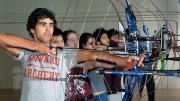No shaky hands, please: stability is crucial. Three stabilizer rods, in fact, are attached to the center of your bow to steady it, like a tightrope walker’s pole. Take a nice, comfortable stance, feet perpendicular to the target. Pick up the bow, then tie together the thumb and middle finger of the hand holding it with a bow sling, a short cord; that’ll keep the bow tight in your palm. Look through the sight with your dominant eye and close the other one. Grasp the bowstring lightly—just the middle three fingers of your dominant hand, please—then pull back smoothly until your hand touches your nose, lips, and chin in the same place it always does. You hear a clicker snap down when you’ve got the arrow far enough back. Release the string and almost instantly your arrow is in the target. But be sure to hold your posture steady for three seconds after release; otherwise the bow will reflect your body motion—and so will the arrow.
“It’s very similar to golf,” says Samuel Saidel-Goley, a junior in the A.L.B. program at the Extension School and tri-captain (with Alice Tzeng ’10 and Tim Soh, a virology student at the Medical School) of the Harvard Archery Club (www.hcs.harvard.edu/archery/index.html). “Controlling your own thoughts and emotions is the key to stabilizing your body. Like golf, on the follow-through you want to keep the same form after the arrow has left the bow.”
Saidel-Goley has been an archer for 15 years and went to the 2008 U.S. Olympic trials, where he finished in the middle of a pack of 100 aspirants. Archery was revived as a club sport at Harvard in 2005 by Nick Batter ’09, who captained the team for four years, and last year the College Archery Program and USA Archery, the national governing bodies, accepted the club. In March, Harvard’s coed team entered the first-ever Ivy League archery championship at Columbia (Cornell also attended). The Lions, who field a women’s varsity squad, dominated the women’s side, and Saidel-Goley was the top-scoring man. (Archery is a purely individual sport; athletes’ scores are not totaled for a team result, though individual winners do represent their colleges or teams.)
Like track and field, archery has both indoor and outdoor versions. Olympic archers shoot outdoors—144 arrows at four-foot-wide targets placed up to 90 meters (nearly the length of a football field) away. Indoor archery, the kind typically practiced in colleges, is scaled down: archers aim at a target a bit over a foot in diameter and 18 meters (59.05 feet) away; each competitor shoots three arrows (an “end”) in two minutes, then retrieves them (one hopes) from the target and tallies the score, repeating the entire process a total of 20 times. (Frequent retrieval of arrows is important because they can easily hit and damage each other; furthermore, an embedded arrow can deflect an arriving one, making its actual point of impact uncertain.) The yellow bull’s-eye on an indoor target is about the size of a half-dollar and worth 10 points; each concentric outer ring (two each of red, blue, black, and white, in order) is worth one point less. Thus with 60 arrows, a perfect score would be 600, and national champions rack up scores in the 570 to 580 range.
The equipment is surprisingly complex: even something seemingly as simple as an arrow has five components: the point, the shaft, the nock (which clips onto the bowstring), the nock pin (attaching the nock to the shaft), and fletching (the “feathers” at the end of the arrow that help stabilize flight). A dozen arrows with tungsten points can cost $700 to $800. “Expensive arrows are a good incentive not to miss the target,” Saidel-Goley says, grinning.
A decent bow can cost $300, but a high-end recurve bow, made of several cast-aluminum and carbon-fiber pieces that lock together (with limbs curving back into an “S” shape), might run $1,500 to $3,000. Luckily, the Archery Club received a generous donation last year from Don Rabska of Easton Sports Development Foundation, in the form of a dozen competitive bows, as well as targets, arrows, quivers, and arm guards. As archers gain skill and strength, they can hold steady with a bow of greater resistance—Saidel-Goley uses a 40-pounder—and so increase velocity. “The faster an arrow gets off the bow,” he explains, “the less time there is to mess it up.”
The newly revived club draws on a long history of archery at Harvard; undergraduates were shooting as members of the Cambridge Tennis and Archery Club in the 1890s, if not earlier. Radcliffe students bagged regional titles in the 1940s and 1950s. Interest peaked at mid century, when archery satisfied physical-education requirements and classes were fully enrolled. “Targets, set up in front of Moors Hall, are frequently not broad enough to receive all the arrows,” reported the Crimson in 1951, “making Moors’s steps an unpopular lounge during shooting hours.” But seasoned archers rarely miss the target, says Saidel-Goley, and in the trauma department, “only Ping-Pong has fewer injuries.”









